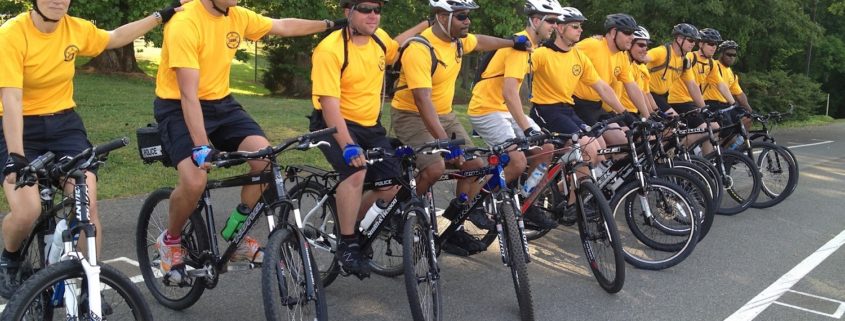Basic Level Courses
Level A Course
Class A certification will only be granted if a minimum of 32-hours, or four consecutive days of mountain bike training covering the following areas of instruction are given, and the student successfully passes a written and practical examination on these areas. Cardiovascular fitness for the police officer including target heart rate.
- Effective cycling & riding protocol
- Bicycle helmets and fit
- Bicycle nomenclature
- Daily inspections & Maintenance
- Bike fit
- Non-collision cycling injuries
- Falling and collision injuries
- Cycling crash prevention
- Gears and cadence
- Nutrition
- Hydration, dehydration and hyponatremia
- Temperature related issues
- Sun damage to the skin
- Police mountain bike dismounts
- Night riding
- Stretching
- Traffic stops
- Complete all practical riding, cone drills & bike as a defensive police tool
- Completed to the satisfaction of the instructor(s)
- Four training rides (minimum) using effective cycling & riding protocol techniques
- Cones drills
- Dismounts
- Emergency braking
- Curbs and stairs
- Bike officer tactics
- Bicycle related firearms training and using LEBA’s range safety rules
Students must pass the written examination by a score of 70%. Practical exercises must be successfully performed and passed to the satisfaction of the Instructor(s) teaching the course. Students must: be able to successfully “Exit” the mountain bike safely and quickly, be able to demonstrate a full emergency braking using the front brake only, the rear brake only, and both brakes, demonstrate a safe and quick simulated arrest of a suspect on foot, and complete training rides using effective cycling techniques to pass this course.
Level B Course
Class B certification will only be granted if a minimum of 24-hours, or three consecutive days of mountain bike training covering the following areas of instruction are given, and the student successfully passes a written and practical examination on these areas. Cardiovascular fitness for the police officer including target heart rate.
- Effective cycling & riding protocol
- Bicycle helmets and fit
- Bicycle nomenclature
- Daily inspections & Maintenance
- Bike fit
- Non-collision cycling injuries
- Falling and collision injuries
- Cycling crash prevention
- Gears and cadence
- Nutrition
- Hydration, dehydration and hyponatremia
- Temperature related issues
- Sun damage to the skin
- Police mountain bike dismounts
- Night riding
- Stretching
- Traffic stops
- Complete all practical riding, cone drills & bike as a defensive police tool
- Completed to the satisfaction of the instructor(s)
- Three training rides (minimum) using effective cycling & riding protocol
- techniques
- Cones drills
- Dismounts
- Emergency braking
- Curbs and stairs
- Bike officer tactics
Students must pass the written examination by a score of 70%. Practical exercises must be successfully performed and passed to the satisfaction of the Instructor(s) teaching the course. Students must: be able to successfully “Exit” the mountain bike safely and quickly, be able to demonstrate a full emergency braking using the front brake only, the rear brake only, and both brakes, demonstrate a safe and quick simulated arrest of a suspect on foot, and complete training rides using effective cycling techniques to pass this course
Level C Course
Class C certification will only be granted if a minimum of 16-hours, or two consecutive days of mountain bike training covering the following areas of instruction are given, and the student successfully passes a written and practical examination on these areas. Cardiovascular fitness and target heart rate, and overview.
- Effective cycling & riding protocol
- Bicycle helmets and fit
- Bicycle nomenclature
- Daily inspections
- Bike fit
- Non-collision cycling injuries
- Falling and collision injuries
- Cycling crash prevention
- Gears & cadence
- Hydration, dehydration and hyponatremia
- Temperature related issues
- Sun damage to the skin
- Police mountain bike dismounts
- Night riding
- Stretching
- Complete all practical riding, cone drills & bike as a defensive tool exercises.
- Completed to the satisfaction of the instructor(s)
- Two training rides (minimum) using effective cycling & riding protocol techniques
- Cones drills
- Dismounts – No take down maneuvers
- Emergency braking
- Defensive tool exercises
Students attending a Class C course must pass the course by successfully passing practical portions of the training to the satisfaction of the instructor. Officers attending a Class C course cannot be accepted as instructor candidates until they have passed a Class B or higher course

